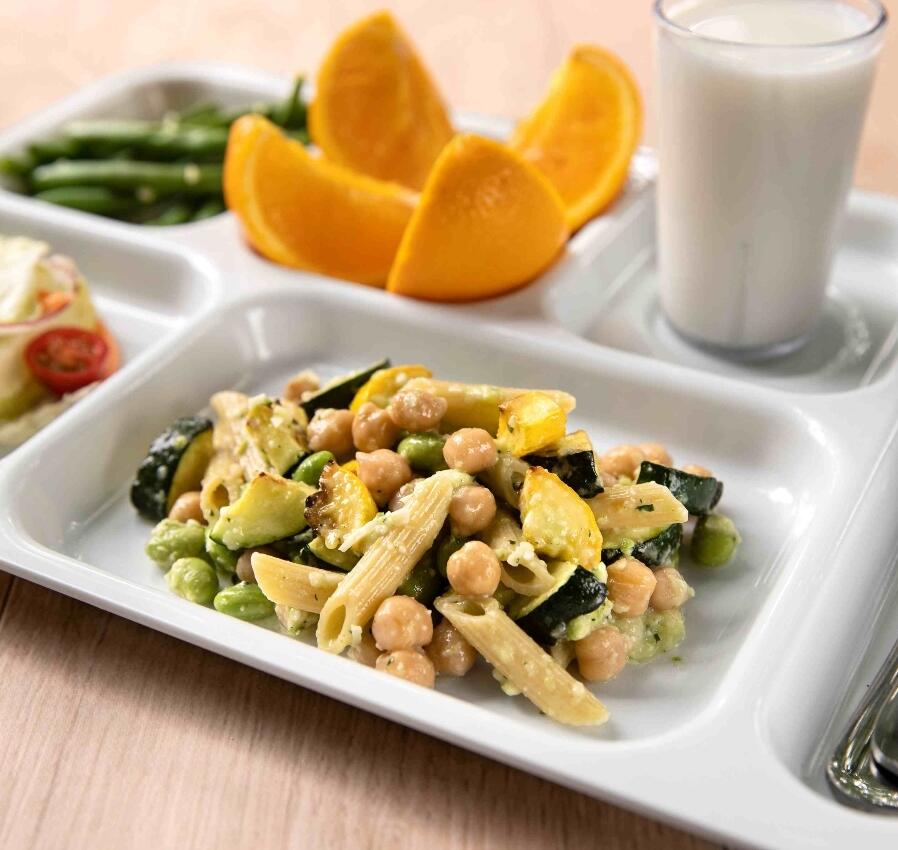
Q&A from our “Child Nutrition Policy in Schools" Webinar
May 31, 2024 | By Sadie Briggs
Here we address 20 questions and insights that attendees shared at our first webinar in the Healthy School Food for Thought series on May 22, 2024.
The first webinar in our three-part Healthy School Food for Thought series, “Nourishing Minds: Exploring Child Nutrition Policy in School Food Systems” aired last week.
Chef Ann Foundation Founder Ann Cooper and CEO Mara Fleishman hosted Emily Broad-Leib from Harvard Law School, Food & Policy Clinic, and Chef Ann Foundation’s Senior Director of Policy MJ Kepner to discuss all aspects of child nutrition policy in school food. The conversation spanned decreasing access to ultra-processed foods, policy achievements, and future focus areas.
We’re so grateful for all the insightful thoughts and questions shared during the session. Time didn’t allow us to answer all the questions that were asked, so we carefully compiled and answered all of the questions below.
If you’re just joining in, watch the hour-long recording anytime.
Q: What are the best things that parents, students, and school food advocates can do (besides federal/state policy) to help support their own schools and districts to build plant-forward, healthy, culturally appropriate meals (especially in non-affluent districts)?
A: One way parents can support school meal improvement is by purchasing the school meals if they are able to. Increased participation helps fund higher-quality meals, more scratch cooking, staffing, and food costs.
The Chef Ann Foundation provides a Parent Advocacy Toolkit to educate parents about the school meal program and its complexities. Parents should understand the program and decide on specific requests to make to their district. Parents educating themselves and advocating effectively can significantly support plant-forward, healthy, and culturally appropriate meals in their district.
Q: As food policy professionals, do you feel like enough advocates work towards this cause?
I idolize Michelle Obama’s school food era. At the time, I was a student in Philly public schools, and the differences were tangible and obvious. Since then, change has felt much more ambiguous. I wonder if that’s because Michelle Obama was so open and clear about her goals.
A: Every presidential administration chooses its areas of focus, and it was significant to have former First Lady Michelle Obama champion healthy school meals and lead on a major piece of school meals legislation like the Healthy, Hunger-Free Kids Act.
The Biden-Harris Administration has made strides toward addressing food insecurity and diet-related diseases, convening the second-ever White House Conference on Hunger, Nutrition, and Health in September 2022, which included conversations about healthy school meals.
Advocacy ebbs and flows, but we at the Chef Ann Foundation are inspired every day by the school food changemakers we meet across the country. You can connect with other advocates by following our work or checking out your state’s Healthy School Meals for All Coalition if they have one.
Q: As an outsider to the school food system (we are a food hub), it’s hard to know how to find the right people to champion the change needed to shift to scratch cooking within the system and spread that throughout the schools/districts. Any advice for taking the first steps for finding and incubating these champions?
A: Start with your local school district. Take an informational meeting. Learn what you can about school food (The Lunch Box and School Food Institute are great places to start). Engage with the National Farm to School Network and see if they can identify any farm-to-school-focused districts in your area.
In many cases, it’s a very relationship-based process. One person can introduce you to five others, and, hopefully, before too long, those connections will bring you to someone in the school system looking for that food hub partner.
Q: Could you address what you’d like to see in the Farm Bill about food waste regarding school kitchens that have unserved food at the end of the day?
We must discard it because we cannot re-serve leftovers or donate the food to local food banks. Some schools are able to compost, or pig farmers can receive the leftovers.
A: The inability to donate food from a school meal program is a misconception, at least at the federal level. USDA’s Food and Nutrition Service clarified in 2012 that any USDA program food can be donated. It may take working with your state agency and local public health department to ensure that schools understand how best to donate excess food.
The solution is less about the Farm Bill — although it can still address waste in our overall food system — and more about educating schools about how to reduce food waste during the preparation process and identifying community partners through food banks to support both food waste reduction and healthy food access.
Q: Isn’t the biggest impact of the Farm Bill on school food the enormous imbalance of subsidies for commodity crops versus specialty crops? The House version proposes to pump up those commodity subsidies significantly.
A: There are active policy conversations taking place around the Farm Bill and crop subsidies. See:
- House Agriculture Committee Chair GT Thompson’s plan.
- Senate Agriculture Committee Chair Debbie Stabenow’s plan.
Chair Stabenow’s draft includes a provision to require the secretary of agriculture to conduct a study to examine barriers to and opportunities for commodity food purchases by USDA, which would affect school food programs.
Q: Do you have any thoughts about regulating fast food establishments from building near schools and building support around having dietitians in schools?
We are challenged with making scratch food that tastes good and falls within the guidelines but also feel pressure from trying to please/educate parents, students, and the school community when there are competing foods and convenience that are right across the street.
A: It is so important to educate parents, students, and the broader school community about the changes school food programs are implementing to improve the quality of their food.
This might include developing a brand for the school food program, updating a school’s website to include more information about its school food initiatives, publishing updates about the school food program in a newsletter for parents or on a school’s social media accounts, displaying informational posters in cafeterias, gathering student feedback from taste tests, and more.
When the school community knows about all of the work being done to improve school food, students are more likely to want to eat it.
The Chef Ann Foundation has developed a number of resources that schools can use to help them market their school food programs and the changes they are making. Schools can find these resources on The Lunch Box, which is our free scratch-cooking resource library for school food professionals. We also frequently provide marketing technical assistance to schools to help them more effectively communicate about their school food program’s goals and the progress they are making toward them.
Lastly, every program relies upon a solid foundation of recipes. Schools can work to create healthy versions of the processed fast food items that schools typically complete with. All of our recipes on The Lunch Box are generated specifically for school kitchens, tested in cafeterias, and kid-approved. Each recipe is analyzed for the USDA meal components and easily adjusted to fit any portion quantity.
Q: Is there space/advocacy for Indigenous food/cultural foods in programs? If so, are there barriers faced in implementation?
I think an important piece in scratch-based cooking is also local food and traditional/Indigenous/cultural food in programs. I am joining from Canada.
A: Scratch cooking in schools provides the opportunity to serve more culturally relevant meals. We believe that serving meals in schools that are traditional to their population’s demographics can be comforting, educational, and familiar.
Chef Ann Foundation participated in an Indigenous recipe project in 2022 in Montana and is currently working with some Indigenous communities through our Get Schools Cooking and Healthy School Food Pathway programs.
The newly released final rule from USDA extends flexibilities for school districts serving traditional Indigenous foods as part of the reimbursable meal.
Q: Can you talk about how increasing the multiplier for Community Eligibility Provision (CEP) would help us in universal meal goals? And the chances of that happening?
A: While USDA lowered the Community Eligibility Provision (CEP) identified student percentage (ISP) threshold from 40% to 25%, it was determined that changes to the CEP multiplier — which is currently 1.6 — would need to come through congressional action.
Increasing the CEP multiplier would make the program more financially viable for schools that have a lower ISP by boosting the percentage of meals that they can claim at the higher free reimbursement rate.
If more schools are able to participate in CEP, more students will have access to free healthy school meals.
There is pending legislation in the U.S. House, the School Meals Expansion Act, that would increase the CEP multiplier to 2.5. This bill is supported by the National Healthy School Meals for All Coalition, of which the Chef Ann Foundation is a member.
Q: To what extent do you feel the new rules lowering the threshold for Community Eligibility Provision (CEP) participation is influencing the universal school meals policy window?
A: Community Eligibility Provision (CEP) is a complicated, two-sided math equation with the ISP percentage and multiplier. Lowering the ISP threshold helps, and we applaud USDA for doing so, but financial feasibility only goes as far as fixing the other side of the equation, which means increasing the multiplier as well, and that’s up to Congress to change.
Q: How do we promote share tables and food donation at all schools?
A: Share tables are tables in students’ common eating areas where students can take their unwanted pre-packaged foods, unopened milk, and/or whole fruit and leave items for other students who would like more food to eat in addition to their required serving.
Please reference the CAF Share Table Standard Operating Procedure for more information about implementing this in your school.
Q: Can stakeholders request a report? Is that part of the appropriations process? Do you have an example?
A: See Appropriations Bills: What Is Report Language for more information.
Q: Is there a relationship between the compensation (not professional development trainings) of school food workers and scratch-cooking opportunities/outcomes?
A: There is a direct correlation. Here at Chef Ann Foundation, we’ve decided to focus on workforce development because if we look into the future of where we want to see school food, we have to forecast what workforce we need to get there.
When examining the system, there are a lot of flaws. There is a lot of work to do to ensure that people understand the value of the school food professional role. Workforce development has been a huge piece of our work — to recruit more folks into the field and get school food professionals trained.
Q: Do you have a specific training or focused resources on procuring local food for schools?
A: The Chef Ann Foundation has a variety of resources that can assist school districts with sourcing local and values-aligned foods. These resources will be posted to The Lunch Box when we launch our new procurement page in late 2024.
Until then, please contact Vanessa Zajfen at vanessa.zajfen@chefannfoundation.org with your questions and/or requests for resources such as bid templates, solicitation trackers, and more.
Q: We want to include farmers in our school food workforce (subsidizing production instead of relying so much on procurement). Is anyone seeing models of production included in the overall scope of a school food authority?
A: There are a number of school production farms/gardens managed by full- or part-time school staff that provide a substantial amount of produce for school meal programs. Some examples include Kelly Miller Farm at Kelly Middle School, Detroit Public School Community District, and IDEA Public Schools.
To learn more about how you can incorporate this into your school, check out LifeLab or the School Garden Support Organization Network.
Q: How do we start to incorporate fermented foods into the school cafeterias?
We fermented sauerkraut in our district but decided the safest way to serve it was to can it, and it lost most of its benefits and probiotics.
A: Fermented foods, such as sauerkraut and kimchi, offer numerous health benefits. However, the process of fermenting foods carries risks, such as the potential for contamination with harmful bacteria or mold if proper hygiene and fermentation conditions are not maintained. We suggest consulting with the local health authority before attempting to ferment onsite.
Q: The challenges that I see for parents/grandparents is the allocation of time and the need for education through demonstration. So many parents are juggling time which negatively impacts children and nutritional value.
A: While important issues facing families — such as earning a living wage and accessing affordable child care — are being addressed by other nonprofits across the country, Chef Ann Foundation’s focus and expertise is healthy, scratch-cooked school meals. Our role in advocating for school food change will hopefully give families one less thing to worry about.
Q: I’m curious about the impact big ideas (like scratch cooking) have historically had on school meals. Is it a process where dreaming big pushes even the most low-income schools in the right direction? Or is scratch cooking a great idea for the schools that can afford it, but unfeasible for low-income schools that may have been able to implement more modest, alternative policies?
A: Scratch cooking is not exclusive to wealthy districts. In fact, it’s imperative that students in under-resourced communities have access to scratch-cooked, healthy meals, as this may be the nutrition that they rely on and it offers them exposure to healthy foods that they may not have at home. Grants from the USDA can help schools acquire the necessary equipment and training.
Dreaming big is in the Chef Ann Foundation’s DNA. We believe every district can take steps toward increasing their scratch cooking, and we’re here to support them in that effort.
Q: We run scratch cooking in 16 schools that include Community Eligibility Provision (CEP) and low-income populations. We are in the beginning stages of designing and opening the operation of a commissary kitchen focusing on processing local food as well as streamlining the scratch-cooking process by producing our own recipes. Do you have any information that you could share to help us get started?
A: Central kitchens are becoming a more popular option for school districts looking to streamline and expand their school food operations. The “Guide to Centralized Food Service Systems” is an excellent publication that covers the many aspects of planning that go into creating a central kitchen. Check out this video on Boulder Valley School District’s central kitchen.
Q: Regarding the Healthy Meals for All initiative in Colorado, many families who can afford meals are participating for convenience, straining resources. From my experience working in schools, many kids don’t take the healthier options, and much of it is wasted. Due to funding shortfalls, would it be better to modify it to a lower income level to qualify, directing more resources to those in need?
A: The Healthy School Meals for All program in Colorado aims to provide every child with access to nutritious meals, regardless of their family’s income. This approach ensures that no child is stigmatized or excluded from receiving a healthy meal, which can be a significant factor in their overall well-being and academic performance.
The Chef Ann Foundation supports the Healthy School Meals for All program and its full funding and implementation so that all children can access healthy, scratch-cooked meals.
Q: How can we find the various new food programs within Ohio, specifically Cleveland? Does this apply only to schools?
I work with children in an afterschool tutoring environment and summer programs (day camp). So many of our meals come from the Cleveland Food Bank.
A: Ohio’s FY24-25 state budget included several provisions around school meals. Public and chartered nonpublic schools participating in the National School Breakfast or Lunch Program must provide breakfast and lunch at no cost to each student eligible for a reduced-price breakfast or lunch. The state will also reimburse the schools 30 cents per reduced-price breakfast and 40 cents per reduced-price lunch served.
We encourage you to reference the Ohio Department of Education and Workforce, Ohio Department of Job & Family Services, and Greater Cleveland Food Bank for more information and resources.
The Chef Ann Foundation will continue to work toward achieving its mission and vision through advocacy efforts that support state and federal initiatives, including those that increase scratch cooking, improve school meal quality, and give school food professionals the tools and support needed to lead this change.
Thank you for your participation, support, and passion for improving child nutrition policy.
Keep Digging In
Stay in touch by signing up for our monthly newsletter and registering for our second webinar on July 8th, “From Waste to Plate: Strategies for Reducing Food Waste in School Food Programs,” featuring Pete Pearson from the World Wildlife Fund.


Keep Digging In
Stay in touch by signing up for our monthly newsletter and registering for our second webinar on July 8th, “From Waste to Plate: Strategies for Reducing Food Waste in School Food Programs,” featuring Pete Pearson from the World Wildlife Fund.







